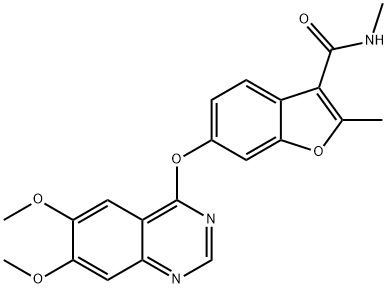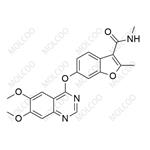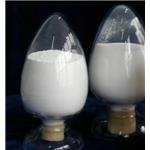Description
Fruquintinib is a VEGFR inhibitor (IC
50s = 33, 35, and 0.5 nM for VEGFR1, -2, and -3, respectively). It also inhibits RET, FGFR1, and c-Kit (IC
50s = 128, 181, and 458 nM, respectively) in a panel of 253 kinases. Fruquintinib inhibits VEGF-A-induced proliferation of human umbilical vein endothelial cells (HUVECs) and VEGF-C-induced proliferation of human lymphatic endothelial cells (HLECs; IC
50s = 1.7 and 4.2 nM, respectively). It decreases tube formation by HUVECs by 74 and 94% when used at concentrations of 30 and 300 nM, respectively. Fruquintinib (0.5-20 mg/kg per day for 21 days) reduces tumor growth in BGC-823, HT-29, Caki-1, and NCI H460 mouse xenograft models.
Uses
Fruquintinib is a multi-targeted tyrosine kinase inhibitor, a third-line regimen involved in the treatment of advanced non-small cell lung cancer in humans. Fruquintinib is a potent, highly selective and orally active inhibitor of VEGFR1, 2, 3 tyrosine kinases.
Uses
Fruquintinib (HMPL-013) is a highly selective VEGFR-1/2/3 tyrosine kinase inhibitor. It was approved by the FDA on 8 November 2023 for the treatment of adult patients with metastatic colorectal cancer. and these patients had previously received fluoropyrimidine, oxaliplatin and irinotecan chemotherapy, anti-vascular endothelial growth factor therapy, and anti-epidermal growth factor receptor (EGFR) therapy. Fruquintinib has also been shown to improve cognitive deficits and pathological changes in a mouse model of cerebral amyloid angiopathy (CAA).
Mechanism of action
By blocking the vascular endothelial growth factor signalling pathway, Fruquintinib inhibits the formation of new blood vessels in tumours, thereby reducing blood supply and inhibiting tumour growth.
in vitro
fruquintinib was found to inhibit vegfr2 with an ic50 of 25 nmol/l. the kinase selectivity of fruquintinib was evaluated against a panel of 253 kinases. the results showed that fruquintinib inhibited vegfr family members with weak inhibition of ret, fgfr-1 and c-kit kinases [1].
in vivo
anti-tumor activity of fruquintinib was evaluated in a variety of tumor xenografts. the results from gastric cancer bgc-823 model seemed to indicate that the drug concentration needs to be at least maintained above ec85 for around 8 hours in order to achieve >80% tumor growth inhibition. bgc-823 was found to be most sensitive to fruquintinib [1].
IC 50
33 nmol/l, 35 nmol/l and 0.5 nmol/l for vegfr1, 2, 3
References
1) Sun?et al.?(2014)?Discovery of fruquintinib, a potent and highly selective small molecule inhibitor of VEGFR 1,2,3 tyrosine kinases for cancer therapy; Cancer Biol. Ther.?15?1635
2) Li?et al.?(2018)?Effect of Fruquintinib vs Placebo on Overall Survival in Patients With Previously Treated Metastatic Colorectal Cancer: The FRESCO Randomized Clinical Trial; JAMA?319?2486
3) Lu?et al.?(2018)?Randomized, Double-Blind, Placebo-Controlled, Multicenter Phase II Study of Fruquintinib After Two Prior Chemotherapy Regimens in Chinese Patients With Advanced Nonsquamous Non-Small-cell Lung Cancer; J. Clin. Oncol.?36?1207



